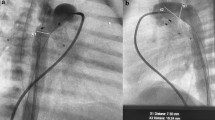Abstract
Biliary atresia is challenging to diagnose because many of the clinical and imaging features of this condition overlap with those of other causes of cholestasis in newborns. When jaundice persists beyond 2 weeks of age, the neonate should be evaluated for cholestasis, and biliary atresia — the most common cause of neonatal cholestasis — should be considered. It is critical to diagnose biliary atresia early because failure to treat can result in hepatic fibrosis and death in less than 1 year. In this paper, we review the current diagnostic imaging methods, differential considerations and treatment options for biliary atresia.










Similar content being viewed by others
References
Fawaz R, Baumann U, Ekong U et al (2017) Guideline for the evaluation of cholestatic jaundice in infants: joint recommendations of the North American Society for Pediatric Gastroenterology, Hepatology, and Nutrition and the European Society for Pediatric Gastroenterology, Hepatology, and Nutrition. J Pediatr Gastroenterol Nutr 64:154–168
Robie D, Overfelt SR, Xie L (2014) Differentiating biliary atresia from other causes of cholestatic jaundice. Am Surg 80:827–831
Roskams T, Desmet V (2008) Embryology of extra- and intrahepatic bile ducts, the ductal plate. Anat Rec 291:628–635
Turkbey B, Ocak I, Daryanani K et al (2009) Autosomal recessive polycystic kidney disease and congenital hepatic fibrosis (ARPKD/CHF). Pediatr Radiol 39:100–111
Shamir SB, Kurian J, Kogan-Liberman D, Taragin BH (2017) Hepatic imaging in neonates and young infants: state of the art. Radiology 285:763–777
Napolitano M, Franchi-Abella S, Damasio MB et al (2021) Practical approach to imaging diagnosis of biliary atresia, part 1: prenatal ultrasound and magnetic resonance imaging and postnatal ultrasound. Pediatr Radiol 51:314–331
Koob M, Pariente D, Habes D et al (2017) The porta hepatic microcyst: an additional sonographic sign for the diagnosis of biliary atresia. Eur Radiol 27:1812–1821
Rozel C, Garel L, Rypens F et al (2011) Imaging of biliary disorders in children. Pediatr Radiol 41:208–220
Schwarz KB, Haber BH, Rosenthal P et al (2013) Extrahepatic anomalies in infants with biliary atresia: results of a large prospective North American multicenter study. Hepatology 58:1724–1731
Hayashida M, Matsuura T, Kinoshita Y et al (2017) Parameters that help to differentiate biliary atresia from other diseases. Pediatr Int 59:1261–1265
Yang L, Zhou Y, Xu PP et al (2018) Diagnostic accuracy of serum matrix metalloproteinase-7 for biliary atresia. Hepatology 68:2069–2077
Tan Kendrick AP, Phua KB, Ooi BC, Tan CE (2003) Biliary atresia: making the diagnosis by the gallbladder ghost triad. Pediatr Radiol 33:311–315
Aziz S, Wild Y, Rosenthal P, Goldstein RB (2011) Pseudo gallbladder sign in biliary atresia — an imaging pitfall. Pediatr Radiol 41:620–626
Kim WS, Cheon JE, Youn BJ et al (2007) Hepatic arterial diameter measured with US: adjunct for US diagnosis of biliary atresia. Radiology 245:549–555
Lee HJ, Lee SM, Park WH, Choi SO (2003) Objective criteria of triangular cord sign in biliary atresia on US scans. Radiology 229:395–400
Park WH, Choi SO, Lee HJ et al (1997) A new diagnostic approach to biliary atresia with emphasis on the ultrasonographic triangular cord sign: comparison of ultrasonography, hepatobiliary scintigraphy, and liver needle biopsy in the evaluation of infantile cholestasis. J Pediatr Surg 32:1555–1559
Tan Kendrick AP, Phua KB, Ooi BC et al (2000) Making the diagnosis of biliary atresia using the triangular cord sign and gallbladder length. Pediatr Radiol 30:69–73
Leschied JR, Dillman JR, Bilhartz J et al (2015) Shear wave elastography helps differentiate biliary atresia from other neonatal/infantile liver diseases. Pediatr Radiol 45:366–375
Hanquinet S, Couvoisier DS, Rougemont A et al (2015) Contribution of acoustic radiation force impulse (ARFI) elastography to the ultrasound diagnosis of biliary atresia. Pediatr Radiol 45:1489–1495
Kianifar HR, Tehranian S, Shojaei P et al (2013) Accuracy of hepatobiliary scintigraphy for differentiation of neonatal hepatitis from biliary atresia: systematic review and meta-analysis of the literature. Pediatr Radiol 43:905–919
Kim YH, Kim MJ, Shin HJ et al (2018) MRI-based decision tree model for diagnosis of biliary atresia. Eur Radiol 28:3422–3431
Sanchez-Valle A, Kassira N, Varela VC et al (2017) Biliary atresia: epidemiology, genetics, clinical update, and public health perspective. Adv Pediatr Infect Dis 64:285–305
Vij M, Rela M (2020) Biliary atresia: pathology, etiology and pathogenesis. Future Sci OA 6:FSO466
Schooler GR, Mavis A (2018) Cystic biliary atresia: a distinct clinical entity that may mimic choledochal cyst. Radiol Case Rep 13:415–418
Back SJ, Maya CL, Khwaja A (2017) Ultrasound of congenital and inherited disorders of the pediatric hepatobiliary system, pancreas and spleen. Pediatr Radiol 47:1069–1078
Han S, Jeon TY, Hwang SM et al (2017) Imaging findings of Alagille syndrome in young infants: differentiation from biliary atresia. Br J Radiol 90:20170406
Bondoc AJ, Taylor JA, Alonso MH et al (2012) The beneficial impact of revision of Kasai portoenterostomy for biliary atresia: an institutional study. Ann Surg 255:570–576
Kasahara M, Umeshita K, Sakamoto S et al (2017) Liver transplantation for biliary atresia: a systematic review. Pediatr Surg Int 33:1289–1295
Acknowledgments
The authors thank Dr. Rama Ayyala for the opportunity to contribute to this neonatal special issue. We also would like to thank scientific writer Megan Griffiths for her assistance with the manuscript.
Author information
Authors and Affiliations
Corresponding author
Ethics declarations
Conflicts of interest
None
Additional information
Publisher’s note
Springer Nature remains neutral with regard to jurisdictional claims in published maps and institutional affiliations.
Rights and permissions
About this article
Cite this article
Brahee, D.D., Lampl, B.S. Neonatal diagnosis of biliary atresia: a practical review and update. Pediatr Radiol 52, 685–692 (2022). https://doi.org/10.1007/s00247-021-05148-y
Received:
Revised:
Accepted:
Published:
Issue Date:
DOI: https://doi.org/10.1007/s00247-021-05148-y




